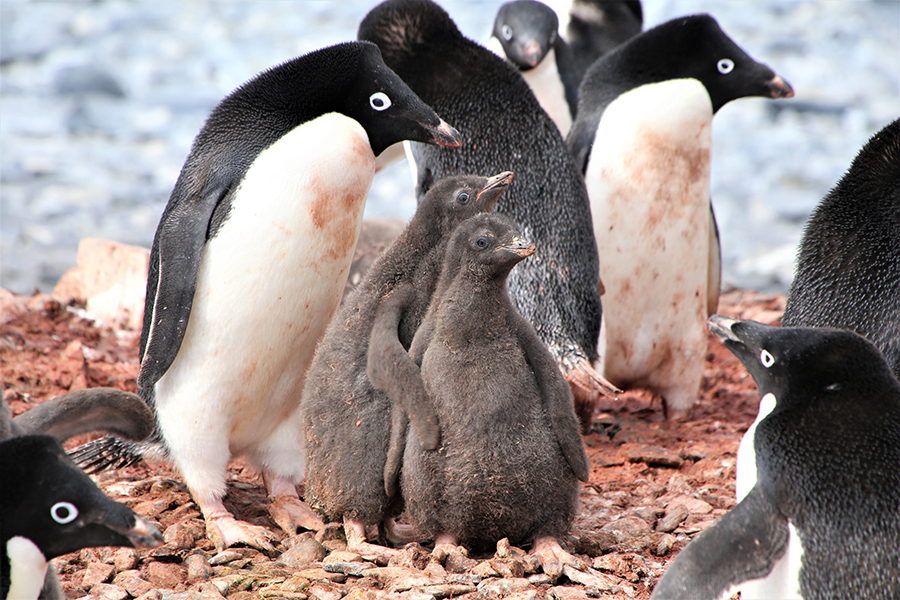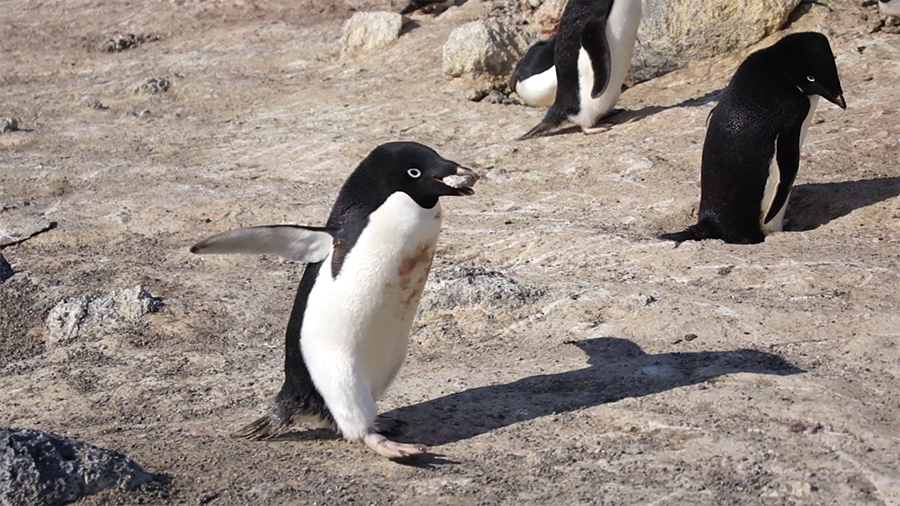The stone thievesCrafty Adélie penguins poach nest-building materials from their neighborsPosted November 09, 2021
Adélie penguins often steal stones from each other’s nests, but new research shows the wily birds target some nests more than others. Biologists observing Adélie penguins on Antarctica’s Ross Island found the birds tend to steal stones from nests on the outside edge of their colony, rather than taking stones from nests in the center. Penguins and other birds who build nests at or near the center of their colonies tend to have better success breeding and raising chicks. Central nests are less likely to be disturbed by predators and are more protected from the harsh Antarctic elements. The new results show there’s an additional benefit to life in the center of the colony: the birds don’t have to worry about others stealing their nest stones quite as often. Stone stealing is more than just a nuisance – it can mean the difference between keeping a chick and losing it. “It’s really important to have a well-shaped nest, and if you have a lot of birds trying to steal your stones, it’s not as easy to maintain,” said Virginia Morandini, an ecologist at Oregon State University and lead author of a new study detailing the findings. “So they need to spend more energy to maintain their nests. If not, they’re more likely to lose their offspring.” Stone by stoneNest building is a major activity for breeding Adélie penguins. The birds spend most of their time in the ocean, but they emerge onto dry land in the austral spring – in September and October – to build nests and raise their chicks. Each penguin couple gathers small rocks and pebbles one at a time, using the stones to line a small depression in the ground they’ve designated as their nest. The stones keep the eggs dry by allowing snow and water to flow around them. 
Photo Credit: Marissa Goerke
An Adélie penguin parent tends to its two chicks at a penguin colony on Torgersen island.
Well-built Adélie penguin nests can have hundreds of stones, and collecting them is painstaking work that requires a lot of energy. It’s also one of the significant ways mated penguins interact with each other, according to David Ainley, an ornithologist who has studied Adélie penguins in Antarctica for decades. “The nest is a focal point, and gathering stones is not just practical, it's also ceremonial,” Ainley said. When eggs are laid, members of the mated pair take turns incubating the eggs and guarding the nest while the other forages for food in the ocean. When one of the pair leaves for their turn in the water, they bring a couple dozen pebbles to their mate before leaving to assure them they will return. “It’s part of the pair formation process,” Ainley said. Coveted building materialsBiologists have been studying Adélie penguins on Ross Island since the 1960s. They track individuals and monitor the population over time, but the slow pace of the research means getting meaningful results can take years. Ainley likens it to watching corn grow. So while they wait, researchers explore other aspects of the penguins’ life cycle and behavior. Morandini was observing penguins at Cape Crozier during the 2017-2018 austral summer when she noticed some birds trying to steal stones from other nests. Cape Crozier is one of the largest Adélie penguin colonies in the world, home to about 600,000 breeding individuals and about 300,000 non-breeders. As Morandini watched the crafty birds steal each other’s nest material, she wanted to learn more about the intriguing behavior. “When I saw them stealing from each other, I wondered what was going on,” she said. Morandini decided to watch the stone thieves more closely and track where they lived in the colony. She marked which nests they attempted to remove stones from more often and how the owners of those nests responded to the attempted thievery. She saw that penguins tend to remove stones from nests on the periphery of the colony more often than from nests near the center. And, not surprisingly, nests near the center tended to be larger and better built. “The peripheral nests had more stone removal attempts, and the removal attempts were more likely to be successful if the nest was on the periphery of the colony,” Morandini said. Nest owners didn’t always tolerate the thievery – they often reacted aggressively by pecking or chasing the pebble poacher or bashing the offender with their flippers. A crime of opportunityStealing stones from a neighbor’s nest is more convenient for a penguin than venturing outside the colony to gather a fresh stone. And Morandini suspects birds choose to steal from peripheral nests rather than those in the center because it’s easier to get away with it. Birds typically walk around the edge of a colony, and those with nests in the center need to cross over the outer nests to get there. Because nests around the outside of the colony see more foot traffic, there are more opportunities for stone stealing. Peripheral nests also have fewer neighbors, so it’s easier to sneak away unscathed. “What we saw in central nests is that when a penguin tried to steal a stone, it’s not only the owner of the nest that is attacking him, but the other neighbors are attacking him at the same time because they see him as a possible problem for them too,” Morandini said. “But nests that are peripheral, they don’t have neighbors on all the sides of the nest. So we think penguins take advantage of that.” Adélie penguins have become more numerous in recent decades, and scientists are unsure why. The new results can’t answer that question but they do help scientists better understand why some penguin pairs are more successful at breeding and raising chicks than others. The findings suggest penguins on the periphery get the proverbial short end of the stick – they have to deal with more stone raids as well as more predators and exposure to the elements. But on the edge of the colony, they’re closer to fresh stones in the surrounding area, so it’s easier for them to replenish their stock. “They have to defend more, but there are more stones available to them,” Ainley said. “So it’s a little six in one, half a dozen in the other.” This work was supported by the National Science Foundation, which manages the U.S. Antarctic Program. NSF-funded research in this story: Katie Dugger, Oregon State University, Award No. 1543459; Grant Ballard, Point Reyes Bird Observatory, Award No. 1543498. |



For USAP Participants |
For The Public |
For Researchers and EducatorsContact UsU.S. National Science FoundationOffice of Polar Programs Geosciences Directorate 2415 Eisenhower Avenue, Suite W7100 Alexandria, VA 22314 Sign up for the NSF Office of Polar Programs newsletter and events. Feedback Form |


